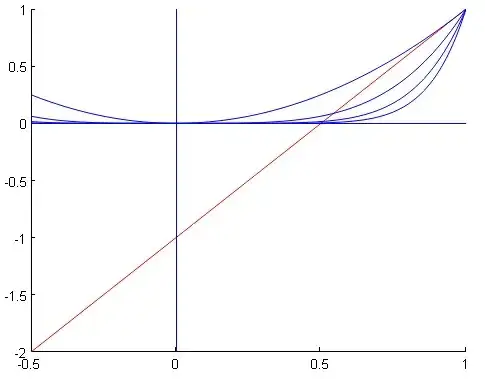Set $x=\frac{1}{X}$ (which is possible because $x=0$ isn't a solution) giving
$$X^{n+1}-2X+1=0.$$
It means that, in this way, we are looking for the abscissas of intersection points of power curve with equation $Y=X^{n+1}$ with straight line having equation $Y=2X-1$.
Moreover, there is always an intersection point at $(X,Y)=(1,1)$.
This provides a clear qualitative view of what happens, with an easy discussion between the cases $n$ even/ $n$ odd.
Let us illustrate the case where $n$ is odd :

Fig. 1 : Polynomial curves with equations $Y=X^{(n+1)}, \ \ n=1,3,5,7$ intersect straight line $Y=2X-1$ in two points points with abscissas 1 and $\tfrac12+\varepsilon_n$.
We see in particular that the second root has the form
$$X=\tfrac12+\varepsilon_n \tag{1}$$
It is solution of the following equation :
$$Y=(\tfrac12+\varepsilon_n)^{\tfrac{1}{n+1}}=2(\tfrac{1}{2}+\varepsilon_n)-1$$
$$\tfrac{1}{a}(1+\tfrac12\varepsilon_n)^{\tfrac{1}{n+1}}=2\varepsilon_n \ \ \text{with} \ \ a:=2^{n+1}$$
$$(1+\tfrac12\varepsilon_n)^{\tfrac{1}{n+1}}=2a\varepsilon_n$$
Taking a first order approximation of the LHS :
$$1+\tfrac{1}{2(n+1)}\varepsilon_n\approx 2a\varepsilon_n $$
Thus $\varepsilon_n \approx \frac{1}{2a-\tfrac{1}{2(n+1)}}\tag{2}$
plugging (2) into (1) (and taking $x=\tfrac{1}{X}$) gives an approximation of the root which is that of @Daniel Schepler.
Remark : A second transformation could be interesting by taking the reciprocal functions, i.e., considering the intersection points between curves with equations
$$Y=X^{1/(n+1)} \ \ \ \text{and} \ \ \ Y=\frac12(X+1)$$
with graphical representation symmetrical of the one given above by exchanging the rôles of $X$ and $Y$ axes (it could be useful in particular for iteration schemes such as Newton's method).
